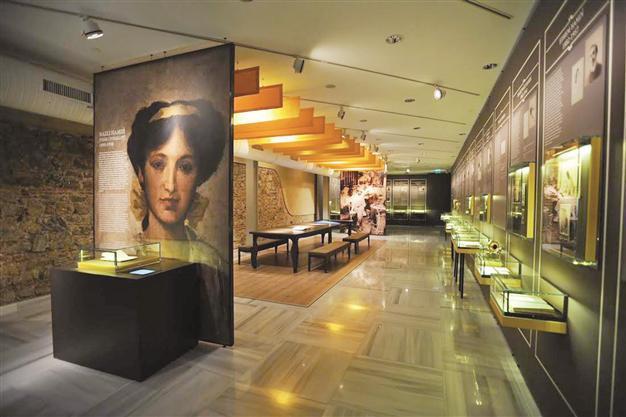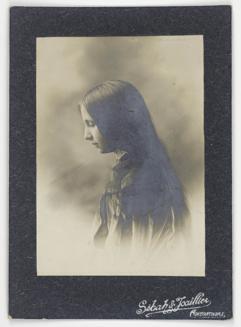Dedications by Osman Hamdi’s daughter
ISTANBUL – Hürriyet Daily News

In the exhibition, each person from the guestbook is introduced by showcases containing documents, images and objects that gives information about their life.
Koç University’s Research Center for Anatolian Civilizations (RCAC) in Istanbul has recently opened its new exhibition, titled “Nazlı’s Guestbook, Osman Hamdi Bey’s Circle.”Osman Hamdi Bey was an Ottoman statesman, intellectual, art expert and also a prominent and pioneering Turkish painter. He is best known with his 1906 painting “The Tortoise Trainer,” which broke a record in Turkey in 2004 with a price of $3.5 million. He was also an accomplished archaeologist, and is considered the pioneer of museum curatorship in Turkey. He was the founder of the Istanbul Archaeology Museums and of the Istanbul Academy of Fine Arts, known today as the Mimar Sinan University of Fine Arts.
 Curated by Edhem Eldem, the exhibition focuses on the guestbook of Nazlı Hamdi, which consists of dedications by the circle of her father Osman Hamdi Bey, including his family, close friends, colleagues, and other acquaintances.
Curated by Edhem Eldem, the exhibition focuses on the guestbook of Nazlı Hamdi, which consists of dedications by the circle of her father Osman Hamdi Bey, including his family, close friends, colleagues, and other acquaintances. The exhibition aims to shed light on the cultural environment of the era following the signatures in the notebook that belong to the leading intellectuals of the period; including the famous archaeologist-spy Gertrude Bell, the founder of the illustrated magazine Servet-i Fünun, Ahmed İhsan, and the crown prince of Bavaria Rupprecht and one of the greatest poetess of late Ottoman literature, Nigar Hanım, among many others.
Traces of individuals
Nazlı Hamdi was the youngest child of Osman Hamdi Bey and his wife Marie/Naile Hanım. Born in 1893, she kept a guestbook between 1907 and 1911 for visitors to sign alongside a few kind words, much like many of her peers at the time. It is this guestbook, bearing traces of over 30 individuals, that makes up the backbone of the exhibition.
The display attempts to present, identify, and relate to Nazlı and Osman Hamdi this mix of visitors: locals and foreigners, men and women, archaeologists, authors, artists, diplomats. At the same time, it examines the story of a woman, who grew up in a Westernized elite family and whose life spanned the late Ottoman period up through the early years of the Republic of Turkey.
 The exhibition is made up of three main themes. First, Nazlı herself and her family: a closely knit inner circle of relatives, some of whom appear in the guestbook. Second, the celebrated villa of Eskihisar and its garden, often depicted in photographs, and where family and friends often met. Third, the last journey of Osman Hamdi to Europe, from July to October 1909, which also took Nazlı and her guestbook to Munich, Luzern, Lausanne, and Paris. These three topics provide a useful framework to understand better the guestbook’s overall context.
The exhibition is made up of three main themes. First, Nazlı herself and her family: a closely knit inner circle of relatives, some of whom appear in the guestbook. Second, the celebrated villa of Eskihisar and its garden, often depicted in photographs, and where family and friends often met. Third, the last journey of Osman Hamdi to Europe, from July to October 1909, which also took Nazlı and her guestbook to Munich, Luzern, Lausanne, and Paris. These three topics provide a useful framework to understand better the guestbook’s overall context. Each person from the guestbook is introduced by showcases containing documents, images and objects that gives information about their life. The guestbook is also digitized and available in tablet PCs in the gallery which allow visitors to read this historical document page by page.
The narrative of the display is an arbitrary one, its limits drawn by the guestbook. The rest is left to what and how much one is able and willing to draw from the mass of information collected on the life, career, or networks of each individual recorded in the guestbook.
However, unexpected connections do appear between some of the guests, to the point where only a virtual medium can tackle the complexity of the emerging web. Beyond its effort to recreate the circle of an Ottoman intellectual, the exhibition is also a historical exercise about trying the potential and the limits of a single but complex document.
Bearing the same title, a book authored by Eldem and published by Homer Publishing House accompanies the exhibition, which will continue through July 10.
















